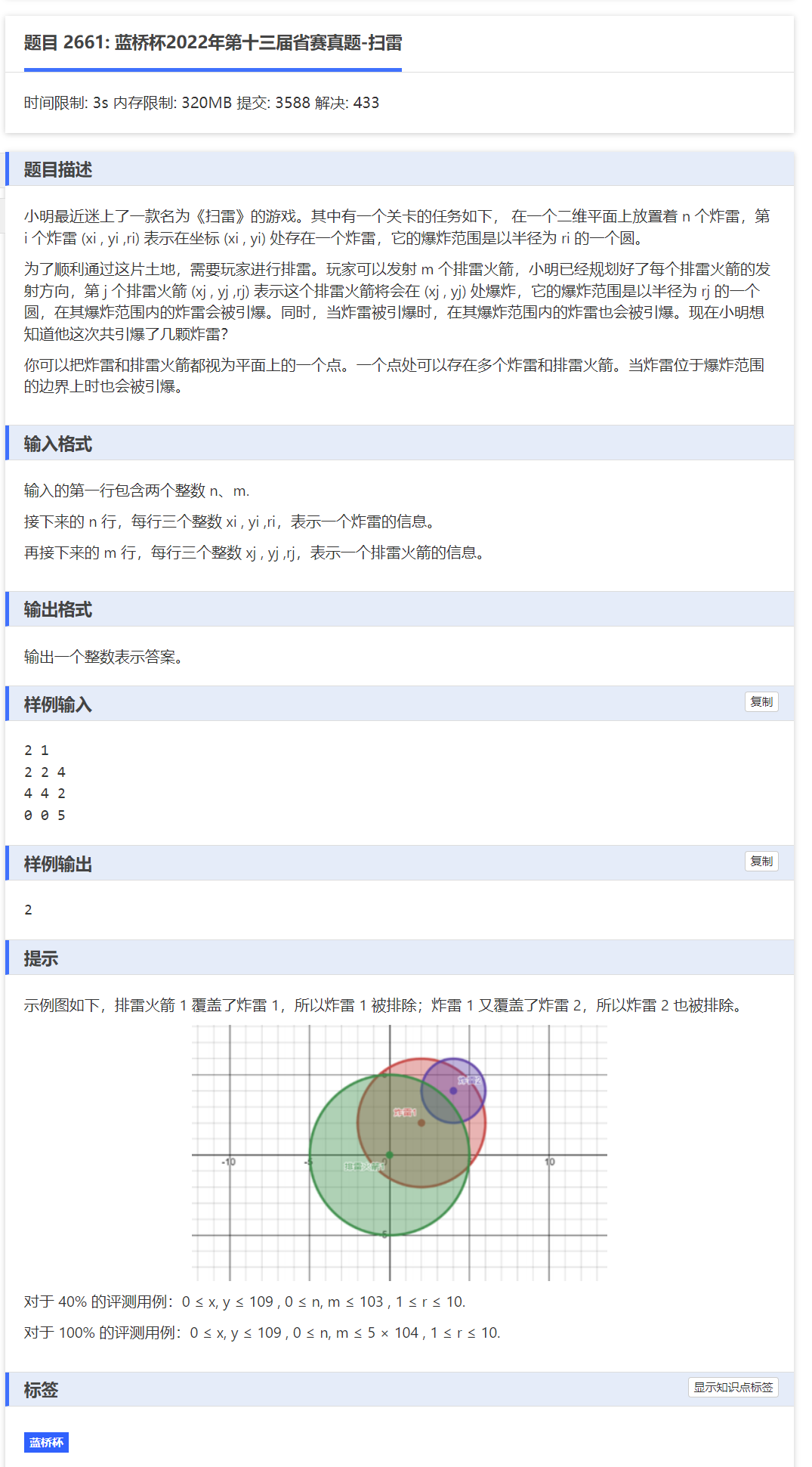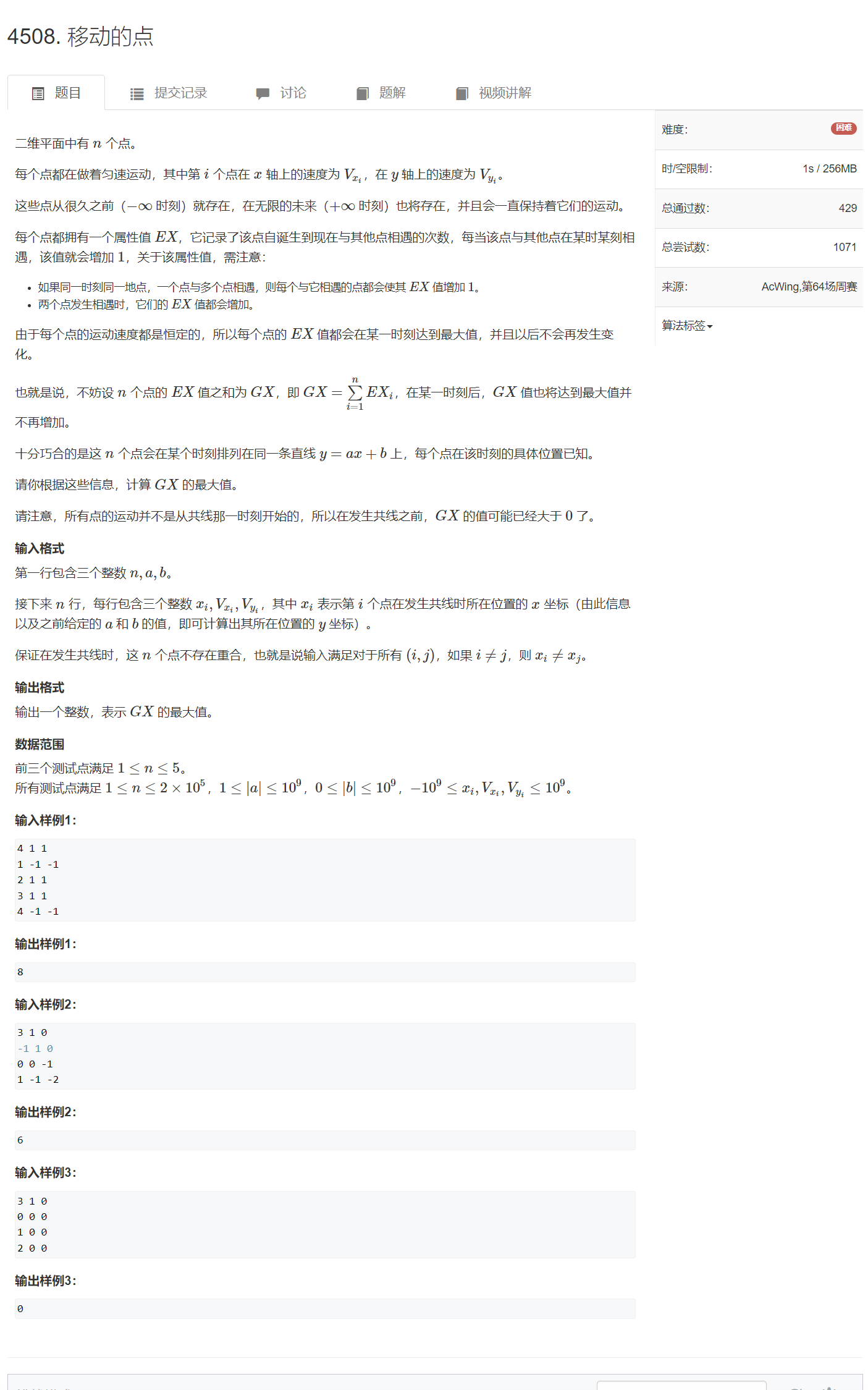题目链接
1.技巧总结
1.1 n进制降维
本题地雷坐标的x,y取值范围过大$( 0≤x,y≤10^9 )$,如果直接把x,y当作下标会爆数组。因此我们可以通过将二维数对{x,y}看作是一个$10^9+1$进制数,高位是x,低位是y,有$(xy)_{10^9+1}=x\times(10^9+1)+y$,于是我们便将一组二维数对{x,y}映射成了一维唯一值,从而达到了编码和降维的目的。
1.2 手写哈希
由于本题数据范围过大,我们如果使用STL中的unordered_map<typename,typename>或者map<typename,typename>在本题中都会有超时风险,于是我们便可以考虑手写哈希函数(据说速度是map的十倍左右)。
1.2.1 哈希模板-开放寻址法(写法较为固定)
int find(LL x)
{
int t = (x % M + M) % M;
while(hash1[t]!=-1&&hash1[t]!=x)
{
t++;
if(t==M) t=0;
}
return t;
}1.3 深度优先搜索-DFS
由于本题每个地雷或者排雷火箭的引爆,会导致其范围内的其他地雷连锁引爆,因此我们可以考虑在每一个排雷火箭引爆点进行dfs查找下一个地雷的位置,再有下一个地雷的位置递归的查找下下个地雷的位置。找到下一个地雷位置之后,统计该点的地雷个数,最后汇总便是最后答案。
时间复杂度近似为$O(r^2n+m)$
#include <bits/stdc++.h>
using namespace std;
typedef long long LL;
const int M = 999997;
const int Base = 1e9 + 1;
int res;
LL hash1[M]; //hash1用于维护find函数
int hash2[M],hash3[M],book[M]; //hash2:地雷在某点的出现次数 hash3:某点的地雷半径 book:标记该点是否被搜索
//Base进制编码降维
LL get_key(int x,int y)
{
return (LL)x * Base + y;
}
//手写哈希函数
int find(LL x)
{
int t = (x % M + M) % M;
while(hash1[t]!=-1&&hash1[t]!=x)
{
t++;
if(t==M) t=0;
}
return t;
}
//判断(x2,y2)是否位于(x1,y1,r1)的范围内
bool judge(int x1,int y1,int x2,int y2,int r)
{
int d = (x2-x1)*(x2-x1) + (y2-y1)*(y2-y1);
return d <= r*r;
}
//dfs
void dfs(int x,int y,int r)
{
for(int i=-r;i<=r;i++)
for(int j=-r;j<=r;j++)
{
int dx = x + i;
int dy = y + j;
LL t = get_key(dx,dy);
if(hash2[find(t)]&&judge(x,y,dx,dy,r)&&!book[find(t)])
{
res += hash2[find(t)]; //答案加上该点地雷个数
book[find(t)] = 1; //标记为已搜索
dfs(dx,dy,hash3[find(t)]); //搜索下一个点
}
}
return;
}
int main()
{
int n,m;
cin>>n>>m;
memset(hash1,-1,sizeof hash1); //hash1初始化为空
for(int i=0;i<n;i++)
{
int x,y,r;
cin>>x>>y>>r;
LL t = get_key(x,y);
hash1[find(t)] = t; //维护哈希函数
hash2[find(t)]++; //统计该点地雷数量
hash3[find(t)] = max(r,hash3[find(t)]); //记录该点地雷半径的最大值
}
for(int i=0;i<m;i++)
{
int x,y,r;
cin>>x>>y>>r;
dfs(x,y,r); //从每一个排雷火箭引爆点开始dfs
}
cout<<res<<endl;
return 0;
}












